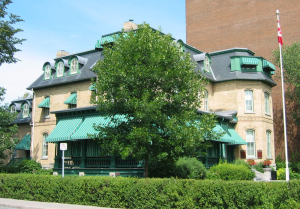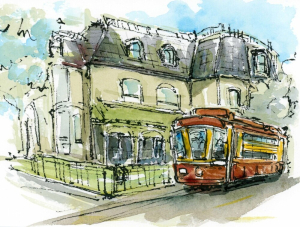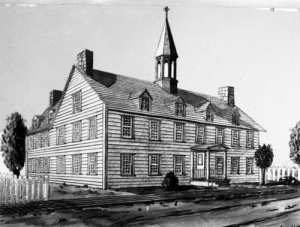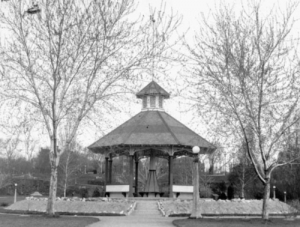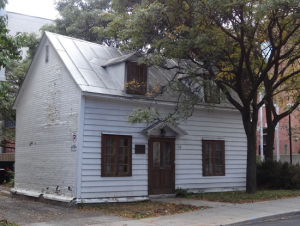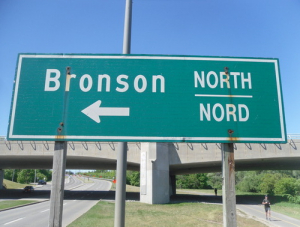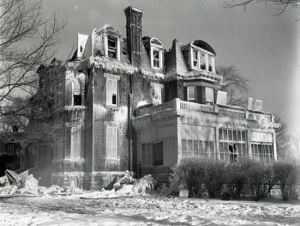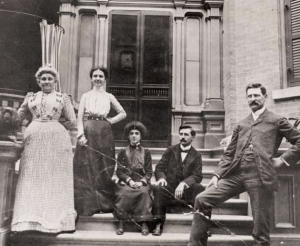HSO Museum Club walks through the history of Sandy Hill
Thursday, July 24th, 2025 dawned sunny and hot as our Museum Club undertook its walking tour of Sandy Hill and its guided tour of Laurier House. In response to the extreme heat predicted for the day, our organizer, Callie Foster, a summer co-op student, and our walking tour lead, Ben Weiss, had arranged to split the group offering a walking tour both before and after the Laurier House tour, so some of our participants could avoid the hottest part of the morning, if they chose to do so. As such, Ben and Callie had to do the walking tour twice in the heat.
Our Parks Canada guide at Laurier House, located at 335 Laurier Avenue East, explained that the house had been built by John Leslie, a prosperous Ottawa jeweler, who moved his family into it in1879. When Wilfred Laurier became Prime Minister in 1896, he needed a suitable place to live in Ottawa, there being no official residence provided by the government at that time. As Laurier was not wealthy, a group of friends came together to purchase the house for $9,500. The Lauriers moved into the house in the fall of 1897 and lived there until their deaths, Wilfred in 1919 and his wife Zoé in 1921. The Lauriers had no children and upon her death Zoé left the house to their friend and then Liberal leader William Lyon Mackenzie King. King was also not a rich man, but again friends stepped forward to pay for the extensive renovations he requested. King moved into the home in January 1923, living there until his death in 1950. He bequeathed the house and most of its contents to the people of Canada and it opened as a museum in 1951.
Our tour of Laurier House, three storeys with lots of stairs, lasted an hour and our guide pointed out many interesting features of the house and kept us all entertained with stories about the Lauriers and King. Laurier House is free to visit, though there is a charge for the guided tour, which I believe is well worth it. They also serve a High Tea and there is a small gift shop in the Visitor’s Centre around the corner on Chapel Street.
The walking tour, led by Ben Weiss, lasted about 1.5 hours and went east along Laurier Avenue East to Charlotte Street, then back along Daly Avenue and on to Wilbrod Street, to Laurier Avenue again and return to Laurier House, though we did veer off a few times to look at specific structures and learn of their historic significance. Due to its proximity to the centre of government and commerce, Sandy Hill became the community of choice for the political and business elite of early Ottawa. It remains a favoured location for embassies and official residences, many of which Ben pointed out as we walked along. This included the Russian embassy at 285 Charlotte Street, where we encountered a small demonstration in support of Ukraine. Ben quickly related the story of the Soviet defector Igor Gouzenko, which in September 1945 started the Cold War, and the fire that destroyed the original building in January 1956 with a delay in fighting the fire caused by the Soviet officials who refused entry to the burning building by the Ottawa Fire Department.
Apart from Laurier and King, a number of other Prime Ministers lived or grew up in Sandy Hill. We passed by houses or apartments which had been lived in by John A. MacDonald, Charles Tupper, Lester Pearson and John Diefenbaker. Two leaders of the New Democratic Party also lived in Sandy Hill, Tommy Douglas and Ed Broadbent. Ben pointed out the former homes of many other famous Canadians including Sandford Fleming, Billy Bishop, Dan Aykroyd, Archibald Lampman, and many many others.
We relaxed in the shade at Strathcona Park, that Ben explained had been through a long transition from swamp, to cow pasture to rifle range and golf course and finally to an extravagant park, since scaled down.
Though Ben did his best to point out many of the significant buildings and tell their stories and those of their generations of occupants, the history of Sandy Hill is so rich that a single walking tour can do little more than scratch its surface. Fortunately, Ben has agreed to return in the summer of 2026 to lead a Sandy Hill Walking Tour Part 2.
Laurier House
11 July 1986
Imagine Wilfrid Laurier stepping out the door of his Sandy Hill home each morning and Canada’s Prime Minister catching a streetcar ride to his office on Parliament Hill every day.
One Ottawa columnist asserted that “Sir Wilfrid’s democratic principles will not allow his riding in anything aught else but trams”. It was said that Laurier relied on his daily conversations with his fellow streetcar riders to keep him in touch with views of everyday Canadians.
(Many thanks to Ottawa artist Tommy Lee for creating this beautiful watercolour and ink rendering, especially for this post, depicting a Ottawa Electric Railway (OER) streetcar pulling up in front of Sir Wilfrid’s house.)
Wilfrid Laurier lived at 335 Theodore St., today 335 Laurier Avene and maintained as a national historic site as “Laurier House”, having been home over time to two Canadian Prime Ministers, Laurier and Mackenzie King, for more than half a century.
In contrast to Canada’s first Prime Minister, John A Macdonald, Laurier was not a wealthy man and had lacked the financial resources to purchase a home befitting a nation’s leader.
As a result, upon Laurier’s election as Prime Minister on July 11, 1896, Laurier’s friends and political supporters pooled together to buy Sir Wilfrid this now-famous yellow brick residence, formerly built as the home of a Sparks St. jeweler. Interestingly, one of those generous financial donors was renowned entrepreneur Thomas Ahearn, a founder and owner of the Ottawa Electric Railway, having just recently launched Ottawa’s first-ever system of electric streetcars. Also, conveniently, one of the new OER’s streetcar lines ended up running right down Theodore St., right in front of Laurier’s new home, with a stop directly opposite his front door.
For the next two decades, and the rest of his life, Laurier remained a famously faithful patron to the OER streetcar system. In fact, when Laurier suffered a stroke working alone in his office on February 15, 1919, Sir Wilfrid rode the streetcar back to home and died two days later. Streetcar usage began to decline in the 1920s and the last of Ottawa’s streetcars came to a stop in 1959. Today there is an OC Transpo bus stop directly in front of Laurier House, with the route name “Parliament” fittingly emblazoned on the sign.
Laurier was not the only Prime Minister to use commonplace means to transport themselves to work. Sir Robert Borden was known to ride his bicycle to work from his home on Lowertown’s Wurtemburg Street. Macdonald liked to walk to Parliament Hill when he lived on Besserer Street. in Sandy Hill and once asked for a precise measurement of his route so he could know how far he walked every day. Jean Chretien preferred a motorized commute to work but, when spotting a tour bus on the way home along Sussex Drive, was known to have his driver pull over to allow the PM to hop aboard and spend a few moments mingling with the out-of-towners.
After Laurier’s death in 1919, his widow Zoé gifted the house to the next Liberal leader, Mackenzie King. Upon his death in 1950, King bequeathed Laurier House to the people of Canada to be preserved as a national historic site. Subsequently, the decision was made that Canada should finally purchase an official residence for its Prime Ministers. In 1951, King’s successor, Louis St. Laurent, (grudgingly) moved into 24 Sussex.
Follow this link if you would like to view more of Tommy Lee's artwork: www.facebook.com/tommyleeartsnow
For more fascinating Sandy Hill history, visit this excellent webpage created by the late François Bregha: www.ash-acs.ca/history
Story written by Ben Weiss. Ben has been part of the HSO communication team for a number of years, managing our Facebook page as well as regular email communications to our members. Ben was coordinator and host for our Speaker Series for several years, is a past recipient of the HSO François Bregha Storytellers’ Award, and continues to serve as an advisor for various projects and committees.
University of Ottawa
26 September 1848
The University of Ottawa was founded on September 26, 1848, as the College of Bytown by Bishop Joseph Bruno Guigues as a bilingual Roman Catholic institution aiming to bridge the gap between Protestants and Catholics as well as anglophone and francophone populations. The bilingual college originally sat in a wooden building (now the former La Salle academy) beside the Notre Dame Cathedral on Sussex Drive and served the educational needs of Ottawa’s population and the Canadian Diocesan and Catholic clergies. The college was incorporated by the Provincial Parliament in 1849 and was moved twice in 1852 before its final move to its current location in Sandy Hill in 1856 due to increase in need for space. It was Louis-Theodore Besserer, a Quebec businessman, notary and political figure who sold a substantial portion of his estate to the college. The university now sat in a stone building to the south of Séraphin Marion and had classrooms and dormitories to accommodate the students living in residence.
Though Bishop Guigues sought funds from the government and land use authorization, the early years of the college was marked with financial difficulties and questioned the college’s existence. Bishop Guigues managed to receive a government funding of £300 in 1857 (roughly $35,000 today) while Regiopolis College, Kingston (a college that focused on education only in English) was awarded £500 in 1847 and continued to receive funding each following year. This made the Diocese of Ottawa fall into debt and the college was eventually sold to the Missionary Oblates of Mary Immaculate in 1856. After the Oblates took over, the college was integrated into the foreign resources of the French order and had eight professors and ninety students which increased to 160 students three years later. The College of Bytown was officially renamed to College of Ottawa in 1861 and was offered university status in August 1866 with the first graduation ceremony taking place in 1890.
Father Guigues’ bilingual mission was continued by Father Joseph-Henri Tabaret who was dedicated to the growth and future university. In 1874, an increasing number of anglophone students and all courses being taught in English only excluding French literature and religion that were taught in French threatened the future of bilingual education in the university. Bilingualism slowly began to be restored in 1894 when the Oblate students pressured Rector Father Henri Constantineau to bring back French education which heightened the Franco-Irish tensions and was resolved when all the Irish Oblate professors, the loudest advocates for English education resigned in 1915.
On the other hand, Father Tabaret pushed towards an expansion that saw over 300 students enrolled by 1886 and made investments into sports by establishing the football team in 1881 and an Athletic Club in 1885. A highly decorated chapel that could seat a 1,000 people was added in 1887. The university also saw the creation of an English Debating Society in 1880, a first of its kind at that time with its French equivalent of Société des débats français followed in 1887. The tremendous growth during Father Tabaret’s period earned the university an ecclesiastic charter issued by the Pope in 1889. Affiliation with other colleges and universities in Canada was made possible through legislation passed in 1891, though it remained unused for the next two decades. At this point the university had just over 400 (all male) students, most in high school level (as the university offered both secondary and tertiary education) and fifty professors.
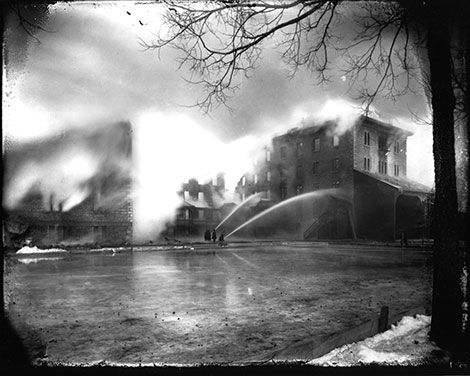 1903 fire - uOttawa ArchivesIn the middle of difficulties (Franco-Irish conflicts and the Ontario Schools Question) that shook the university in the early 20th century, on December 2, 1903, a fire destroyed the college’s main building, costing three lives and the lost of several historical records. New York Architect A. O. Von Herbulis was appointed to design the Tabaret Hall in a Greek Neo-classical style which replaced the main building, and it was opened in 1905. The new building was named after Father Tabaret to recognize his contributions to the university over 30 years of his tenure.
1903 fire - uOttawa ArchivesIn the middle of difficulties (Franco-Irish conflicts and the Ontario Schools Question) that shook the university in the early 20th century, on December 2, 1903, a fire destroyed the college’s main building, costing three lives and the lost of several historical records. New York Architect A. O. Von Herbulis was appointed to design the Tabaret Hall in a Greek Neo-classical style which replaced the main building, and it was opened in 1905. The new building was named after Father Tabaret to recognize his contributions to the university over 30 years of his tenure.
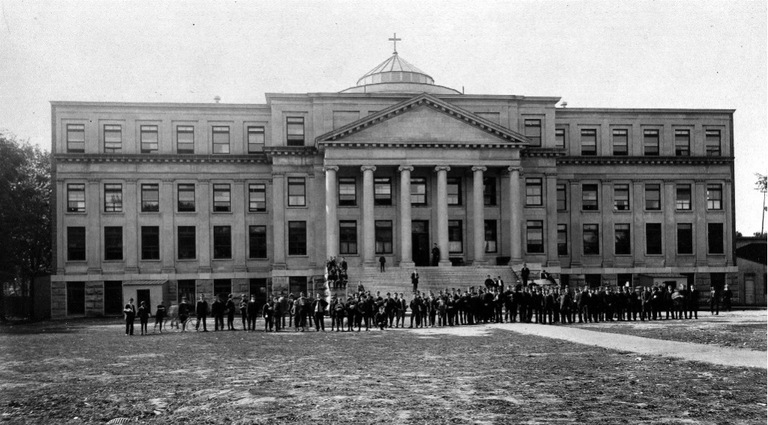 Tabaret Hall circa 1905 - uOttawa Archives
Tabaret Hall circa 1905 - uOttawa Archives
Though World Wars did not impact the university significantly, it should be noted that interwar years were important and contributed to the university’s growth given that this was the only Catholic institution offering education in French outside of Quebec in Canada. This paved way for the affiliation of twenty-four colleges and convents (many being francophone) in Ontario and the Western provinces with the university. Women were allowed to register into courses in 1919 and between 1922 and 1936, the university saw further expansions with the establishment of school for teacher training, nursing, and faculty of canon law and arts. With this rapid growth, the university rewrote its civil charter according to the provincial legislations in 1933 and was renamed as the “University of Ottawa”. The pontifical charter was also rewritten to meet the Pius XI’s Apostolic Constitution’s requirements and was approved by Rome in 1934. The economic boom after the end of the Second World War led to the creation of nine faculties and four schools by 1965.
In 1959, the university acquired expropriation powers to expand the Sandy Hill campus to meet the growing enrollments. This caused the university to fall into deficit every year in the 1960s and it began talks with the provincial government with the province demanding the Oblates to pass over the power to the government.
“The year 1965 marked the end of one era and the beginning of another.”
- Saint Paul University History (n.d.). Retrieved from ustpaul.ca/en/about-spu-history_493_360.htm
After rigorous negotiations with the provincial government, the Oblates handed over control to the province in 1965. The old university came to be called Saint Paul University and the province formed a new university which was named as the University of Ottawa according to the University of Ottawa Act, 1965. They became a federated institution and share the faculties. Roger Guidon who was appointed as the Rector of the old university in 1964 remained Rector of the new university until 1984. During his tenure, he modernized the university, hired substantial numbers of lay faculty, support staff and women. The number of professors had increased from 300 in 1965 to 1000 in 1990. Financial aid from government also helped further the university’s expansion well into 2000. Regarded as the largest bilingual university in North America, today it comprises of four campuses covering 42.5 hectares with more than 40,000 students and 5,000 employees and offers over 450 programs in 10 faculties.
Sources
About uOttawa. (n.d.). Retrieved from https://www.uottawa.ca/about/
Jones, D. (2017, May 12). 8. Académie de-la-salle. Retrieved from https://heritageottawa.org/fr/50years/la-salle-academy
Saint Paul University History. (n.d.). Retrieved from https://ustpaul.ca/en/about-spu-history_493_360.htm
Strömbergsson-Denora, A. (2012, February 8). University of Ottawa. Retrieved from https://www.thecanadianencyclopedia.ca/en/article/university-of-ottawa
The University of Ottawa. (2019, July 20). Retrieved from https://www.ash-acs.ca/history/the-university-of-ottawa/
Image Credits
Strömbergsson-Denora, A. (2012, February 8). University of Ottawa. Retrieved from https://www.thecanadianencyclopedia.ca/en/article/university-of-ottawa
The archives turns 50. (2017, February 27). Retrieved from https://www.uottawa.ca/gazette/en/news/archives-turns-50
Story written by Nivethini Jekku Einkaran, an architectural conservation graduate from Carleton University. She has an undergraduate degree in architecture from India and is a registered architect in India where she worked as a junior architect before moving to Canada. Nivethini is a volunteer with The History Society of Ottawa.
HSO Community Project Chosen
The Society’s Board of Directors is delighted to announce that it has approved a pledge of $5,000 towards a project to construct a replica gazebo at Strathcona Park. This project was proposed by HSO member, François Bregha.
At last year’s Annual General Meeting, members agreed to allocate funds to finance community projects over the coming years. Members were asked to suggest potential projects, and a process was established to choose among projects. The selection process was based on a number of criteria, including relevance to HSO’s mission and objectives, cost, and the availability of people to take the lead on the project.
The construction of a replica pavilion at Strathcona Park has long been the dream of Action Sandy Hill, a local community group. Strathcona Park, which is located on the western bank of the Rideau River, was originally the home of the Dominion Rifle Range. During the early 20th century, the range was turned into a park by the Ottawa Improvement Commission, the forerunner of the National Capital Commission. The park is now maintained by the City of Ottawa.
The park was named in honour of Scottish-Canadian businessman, financier and politician Donald Smith who became 1st Baron Strathcona and Mount Royal in 1900. During the nineteenth century, Smith was president of the Bank of Montreal, and co-founded the Canadian Pacific Railway with his cousin George Stephen, later known as Lord Mount Stephen. Smith also for a time represented Montreal in the House of Commons. Later, he became Canada’s High Commissioner to London. Lord Strathcona was also a great philanthropist, endowing hospitals, including the Royal Victoria Hospital in Montreal. He was also Chancellor of McGill University and the University of Aberdeen.
A feature of Strathcona Park is a large fountain sculpture by Mathurin Moreau which was donated by Lord Strathcona in 1909. The four standing figures supporting a bowl represent Europe, Asia, Africa and America. Another original feature of the park was a Victorian-style gazebo, the site of many band performances and other events. Unfortunately, the aging gazebo was dismantled in 1961 and never replaced. The initiative of Action Sandy Hill to re-build the gazebo will restore a historic structure and provide a new focal point for the Park.
Planning for the structure is well advanced. Action Sandy Hill (ASH) will allocate up to $26,000 to this endeavour using money received from a developer earmarked for community benefits. The City of Ottawa has agreed to match the ASH funds. Heritage architect Barry Padolsky is contributing the gazebo design and specifications pro bono. Action Sandy Hill held a community consultation on the gazebo in September 2020 and is looking for estimates for its construction. It is also seeking funds from the broader Ottawa community to complete the financing.
The Historical Society of Ottawa is delighted to support this initiative to rebuild the gazebo and reintroduce a lost historical artifact in a well-used and much-loved park.
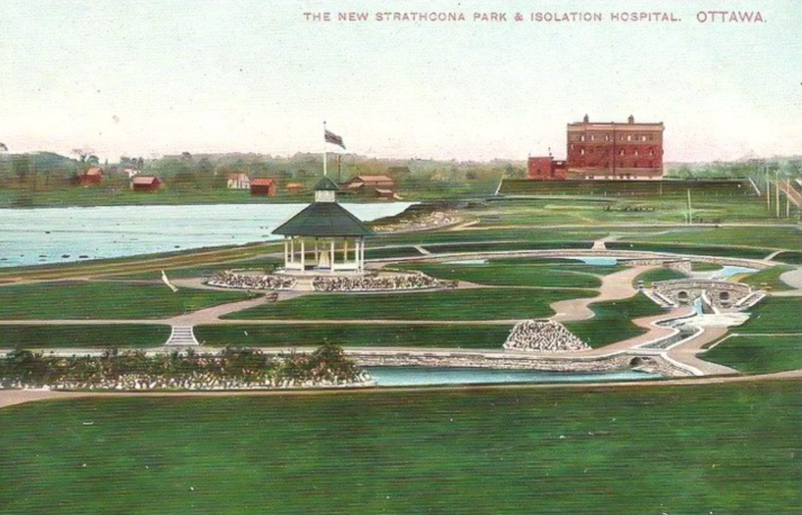
The tall building in the background is the isolation hospital, now the site of an apartment building.
Old Buildings
June 1827
A while back I told you about the Old Registry Office that was built in 1873. There are even older buildings around Ottawa and many of them can be seen in a quick trip around Lower Town and in Sandy Hill. A cluster of them is viewable near the Basilica at Sussex and St. Patrick. The Basilica itself is one of the oldest surviving structures in Ottawa.
The oldest of all Ottawa buildings is the Bytown Museum beside the canal, built in 1826 as Colonel By's storehouse for the construction of the Rideau Canal. The Canal was officially opened 175 years ago, in 1832. Houses were built in Lowertown as the community grew and, as Canada became a nation, many upscale houses were built in Sandy Hill. This article will focus on a few of these house, but a good walking tour will show off even more.
... to tell the stories of some of the people who have lived here over the last 175 years.
There is a particularly well-preserved house at 138 St. Patrick Street that belonged to Flavien Rochon. Built circa 1832, it is typical of a workingman's home of the era. Before it became the property of Mr. Rochon, four sisters of the Grey Nuns of the Cross (now the Sisters of Charity of Ottawa) lived there from 1845-1851. Mr. Rochon was a carpenter by trade who also sculpted wood and who was involved in the construction of both Notre Dame Basilica as well as the Parliamentary library. The house was acquired by the National Capital Commission in 1965. His next door neighbour at 142 St. Patrick was Dr. Francois-Xavier Valade whose imposing house was built circa 1864. The Valade house is typical of ancestral homes in Normandy. Dr Valade lived there from 1866 to 1918, was one of Ottawa's first doctors and was also one of the doctors responsible for examining Louis Riel before Riel's 1885 trial in Regina. The house was known as Le Balcon Blanc because of the white veranda overhanging the entrance. The original balcony was replaced at the beginning of the twentieth century.
Before leaving Lowertown for Sandy Hill, we should mention Notre Dame Basilica, the oldest church in the capital, built between 1841 and 1865 on the site of an earlier church built in 1832. It contains beautiful statues and woodwork carved by Louis Philippe Hebert, Phillipe Pariseau and Flavien Rochon whose house was described above. The tower of the Basilica stands nearly 55 metres high and the organ has more than 4000 pipes!. This just a small sample of buildings constructed before Canada became a nation in 1867.
Louis Besserer, a notary public from Quebec, owned a large parcel of land that became the area known as Sandy Hill, one of the first “elite” neighborhoods in Ottawa. Besserer had inherited the land from his deceased brother René-Léonard Besserer (d. 1823) in 1828, but the area did not really develop before Ottawa was picked as the site of Canada's capital by Queen Victoria in 1857. Growth accelerated after Confederation and the area became home to many politicians and senior government officials.
One of the oldest houses in Sandy Hill is the Besserer House built c. 1844 where L. J. Besserer lived from 1844 to 1866. It was later occupied by W. T. McDougall, one of the fathers of Confederation. The house is at 149 Daly Ave and is really the center of Sandy Hill development. Some changes to the verandas and the western face have taken place since 1844, but the house is still largely the same as when it was originally built.
Another older house is the Lyon house, built c. 1850. Its first occupant was a son of the original builder Colonel George Lyon Fellowes. Robert Fellowes, the son, was a member of Parliament and in 1876, the Mayor of Ottawa. The pamphlet put together by the Regroupment des Organismes du Patrimoine Franco-Ontarienne states as follows “The bay window, the magnificent wooden portico, and the decorative flourishes on the facade make it one of the most charming residences. ” The Toller House, built c. 1875. Its first occupant, T. Fournier, was a creator of the Supreme Court of Canada and one of the first Justices. The next occupant, for whom the house is named, was Frederik Toller, Auditor General of Canada The next occupant was Louis-Phillipe Brodeur who was simultaneously Minister of Finance and Oceans, a Justice of the Supreme Court and Lieutenant Governor of Quebec. How he managed to handle all four jobs, we'll have to guess! The City of Ottawa designated the house an historic property in 1982.
These are only a few of the historic buildings in downtown Ottawa. Take a tour and discover much, much more!
Cliff Scott, an Ottawa resident since 1954 and a former history lecturer at the University of Ottawa (UOttawa), he also served in the Royal Canadian Air Force and the Public Service of Canada.
Since 1992, he has been active in the volunteer sector and has held executive positions with The Historical Society of Ottawa, the Friends of the Farm, and the Council of Heritage Organizations in Ottawa. He also inaugurated the Historica Heritage Fair in Ottawa and served on its organizing committee.
The Origins of Street Names
January 1820
Considering how many people in Ottawa are new to the city, it seemed reasonable to do a little research and find out who, or what, some of the oldest Ottawa streets are named after. Many persons who contributed to the foundation and growth of our City are not well known, and I understand both City staff and the Historical Society of Ottawa have developed tentative plans to make early Bytowners or Ottawans better known. This is a project deserving support! No article of this size can hope to do much more than scratch the surface of this topic. So only a few streets are covered.
Much has been said and written about the proper use of Lebreton Flats which contained Lebreton Street. These were named after Charles LEBRETON (1779-1848) who was a native of Jersey and one of Nepean Township's earliest settlers. He came to our area from Newfoundland and served with distinction in the War of 1812. With a partner, he purchased Lebreton Flats in 1820 and, in 1826 got into a legal wrangle with Colonel By and the Governor General, Lord Dalhousie over the price he wanted for his land. He spent a good deal of money defending the legality of his land ownership against the government of the day He retained his land, but the Rideau Canal was built elsewhere probably because Dalhousie and By rather disliked him after the court battle. Was sour grapes involved in the location of the canal?
Nicholas SPARKS (1792-1862) for whom Sparks Street is named is much better known,. but the extent of his good works in Ottawa is less known Sparks came to Canada in 1816, from Ireland, to avoid religious strife. He married the widow of Philemon Wright Jr. in 1826. He owned a sawmill and vast timber rights in the area. In 1821, for the equivalent of $500 he purchased land that extended from what is now Wellington St. to Laurier Avenue West and from Waller Street to Bronson Avenue. He sold part of his land to construct the Rideau Canal, but, because of the price he asked, another 96 acres were expropriated much to his chagrin!
Perhaps wishing to avoid religious strife in Canada, he donated land for churches to both the Anglicans and the Presbyterians. Sparks went on to serve for many years in local government. Sparks named a street on his land after a friend, Daniel O' CONNOR, who became Treasurer of the Dalhousie District (later Ottawa-Carleton) and another after his son-in-law, James SLATER Slater Street was first named Waugh Street, after a local merchant Caldwell Waugh., James Slater came to Canada about 1830, married Sparks' daughter in 1847 and went on to be, successively, Provincial Land surveyor, Superintendent of the Rideau Canal and Chairman of the Ottawa School Board.
Robert BELL (1821-1873) was a promoter of railway construction, a land surveyor and eventually, a journalist. He bought the Bytown Packet in 1849 and two years later changed the name to the Citizen, He sold the paper in 1865 to I. B. Taylor. One of the people from whom he bought the paper, Henry J. FRIEL (1823-1869) served as Mayor of Bytown in 1854 and Mayor of Ottawa in 1857, 1863, 1868 and finally, 1869 Pictures of both Bell and Friel are available at the City Archives.
More streets named after prominent Ottawa residents
In Lower Town, Bruyere Street is named after Mother Elizabeth BRUYERE (1818-1876) the founder of the Grey nuns and the Ottawa Hospital (1845) She also established an orphanage, a hospice and an asylum for destitute women. GUIGUES Street is named after Monsignor Joseph-Eugene—Bruno Guigues (1805-1874), Ottawa's first Roman Catholic Bishop. He founded what became the University of Ottawa on land donated by Louis BESSERER.
Further west, BRONSON Avenue was named after Erskine Henry Bronson, a prominent businessman, whose father Henry Bronson had founded a local lumbering firm. Speaking of lumbering, who else could BOOTH Street be named after other than J. R. Booth “the Ottawa Valley Lumber King”.
These are only a few of the origins of Ottawa street names. The City of Ottawa Archives is working on identifying many more.
Cliff Scott, an Ottawa resident since 1954 and a former history lecturer at the University of Ottawa (UOttawa), he also served in the Royal Canadian Air Force and the Public Service of Canada.
Since 1992, he has been active in the volunteer sector and has held executive positions with The Historical Society of Ottawa, the Friends of the Farm and the Council of Heritage Organizations in Ottawa. He also inaugurated the Historica Heritage Fair in Ottawa and still serves on its organizing committee.
The Soviet Embassy Fire
1 January 1956
It was Sunday, 1 January 1956. Like most New Year’s Days, revellers from the previous night’s festivities were nursing sore heads. With Monday being a holiday, many Ottawa residents were happy to laze about the house and enjoy their long weekend. The virtuous and hardy braved sub-zero Fahrenheit temperatures to go to church, or attend the annual Governor General’s New Year Levee. Held on Parliament Hill, more than 1,000 Ottawa residents filed into the crimson and gold Senate chamber late that morning to be greeted by Governor General Vincent Massey, before receiving a glass of punch and a light lunch in the nearby Railway Committee Room. As was customary at the time, it was a very masculine affair. Other than Charlotte Whitton, Ottawa’s formidable mayor, and some female members of the armed forces, there were very few women present. The city’s diplomatic corps was well represented, however. Among the foreign dignitaries at the reception to shake Massey’s hand were three uniformed representatives of the Soviet Embassy. Little did they realize they were about to have a very bad day.
Following the levee, which ended in the early afternoon, the three Russian officers undoubtedly hurried back to the Soviet embassy for their own New Year’s celebrations, hosted by Ambassador Dimitri Chuvahin. Located at 285 Charlotte Street in Sandy Hill, the embassy building had once been the mansion of the Booth family, Ottawa’s lumber barons. Requisitioned by the Canadian government in 1942 for use by the Royal Canadian Women’s Naval Services, the house was instead turned over to the Russians to house the growing Soviet legation. As guests left the Soviet reception at about 4.15pm, Miss Diane Destonis, a neighbour living in the apartment building across the street, spotted smoke drifting from a window on the third floor of the embassy building. Another neighbour, Mr W. Dore, also saw the smoke. Believing it was a kitchen fire, he tried to alert the Soviet embassy by telephone; he received no reply.
The fire was caused by an electrical short circuit in the embassy’s communications room located on the upper floor of the three-storey building. Instead of immediately calling the Ottawa Fire Department for assistance, Soviet diplomats tried to put out the blaze themselves using hand extinguishers and a small fire hose installed in the building. Thirty minutes passed before the alarm was raised. Although firefighters were on the scene within ten minutes of receiving the call, flames had already engulfed the third floor. Entering by the front door of the embassy, Ottawa’s firemen, led by Chief John Foote, were stopped by embassy staff claiming diplomatic immunity. A Soviet official actually struck Chief Foote; the incident was later played down. Denied access to source of the fire, the firemen were obliged to tackle the blaze from the outside. The Soviet diplomats also impeded the firemen’s efforts by refusing to vacate the premises. Instead, they repeatedly went in and out of the embassy to retrieve filing cabinets, boxes, and files of documents. The last item to be saved from the flames was “a heavy piece of wireless equipment.” Two embassy cars, stuffed with documents, reportedly “careened” out of the embassy driveway onto Charlotte Street, running over deployed fire hoses, almost bursting them.
Incensed by the lack of Soviet co-operation, Chief Foote contacted Mayor Whitton who hurried to the scene. Shortly afterwards, R. M. Macdonnell, the deputy undersecretary of External Affairs arrived, as did Paul Martin, Sr, Minister for National Health and Welfare, substituting for Lester Pearson, Minister for External Affairs who was out of town. The mayor authorized Chief Foote to exercise all necessary emergencies powers at his disposal as Fire Marshall. At 6.30pm, he declared a state of emergency, calling in extra firemen and police support.
The fire was finally brought under control two hours later, but was not extinguished until close to midnight. One hundred firemen fought the blaze in biting cold weather, using equipment from four stations, including three pumper trucks and four ladder trucks. Although smoke and hot cinders filled the sky, a north-easterly breeze blew burning embers towards parkland and the Rideau River, sparing the embassy’s neighbours. More than three thousand spectators watched the night’s drama despite the cold. Hundreds of cars lined Riverside Drive. Meanwhile, streetcar service along Laurier Avenue East was blocked.
Thankfully, no lives were lost in the fire. But the embassy building was a write-off. Estimated losses amounted to $250,000 (equivalent to more than $2 million today). Ambassador Chuvahin and his wife, along with two other Soviet diplomats living in the building, lost their homes and their belongings. The Soviets set up a temporary embassy a short walk away at 24 Blackburn Avenue, the office of the Soviet commercial counsellor.
The next day, with the embassy building sheathed in ice, the blame game commenced. The Soviets claimed that the Ottawa Fire Department had been slow to respond, and that there had been insufficient water pressure. Mayor Whitton hotly denied the allegations, saying that the Russians had only themselves to blame by not calling in the firemen immediately, and then obstructing their access to the building. She also argued that the six-foot, spiked, iron fence installed around the perimeter of the property the previous year had made it difficult for fire equipment to be brought close to the embassy building. Additionally, extreme cold temperatures meant that water being directed onto the blaze vapourized before contact. At the city’s official New Year Reception held that afternoon, a hoarse and weary Mayor Whitton commented, “I’ve been fighting the Russians.”
The public was baffled by the Soviet effort to obstruct Ottawa’s firemen. A Citizen editorial called it “an incomprehensible act,” which put its neighbours at risk. Claims of “diplomatic immunity” in such circumstances were deemed “fantastic.” Igor Gouzenko, the Soviet cypher clerk who had defected from the Soviet Embassy nine years earlier, explained that the only reason for embassy officials to impede and delay Ottawa’s firemen was to ensure that it’s most secret documents, for example, lists of names of agents in the west and instructions from Moscow, were kept secret.
Mayor Whitton called upon the federal government to review its regulations governing diplomatic immunity in order to give firemen free access to buildings in the event of future fires. The government demurred, arguing that international rules governing diplomatic immunity had been finely crafted over many centuries, and that Canadian officials abroad were accorded the same privileges as foreign representatives were in Canada. When contacted, other diplomatic missions in Canada were also wary of any change to the law, though several commented that they would have allowed the firemen onto their premises had their embassies caught fire.
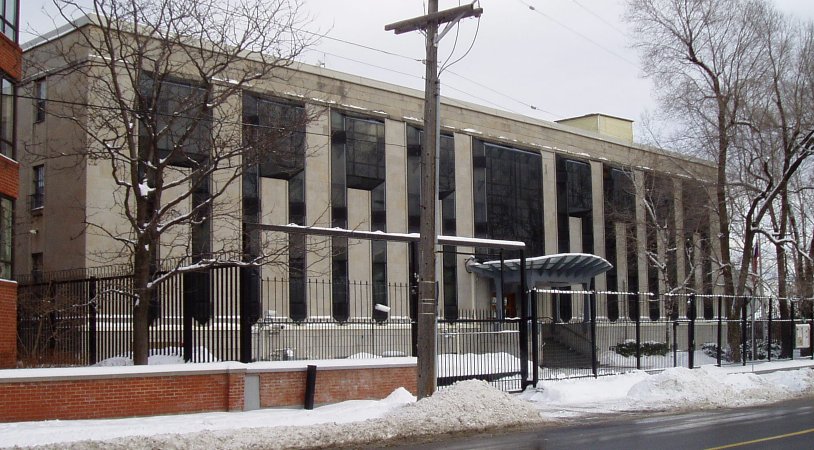 With the old Booth mansion a write-off, a new Soviet Embassy, built in the Socialist Classical style, was constructed on the same site. With the Cold War in full swing, RCMP counter-espionage agents, assisted by British MI5 agents, apparently concealed microphones in the windows of the new building while it was under construction. Called Operation Dew Worm, Igor Gouzenko provided advice to the Canadian and British spooks on the best locations to place the bugs.
With the old Booth mansion a write-off, a new Soviet Embassy, built in the Socialist Classical style, was constructed on the same site. With the Cold War in full swing, RCMP counter-espionage agents, assisted by British MI5 agents, apparently concealed microphones in the windows of the new building while it was under construction. Called Operation Dew Worm, Igor Gouzenko provided advice to the Canadian and British spooks on the best locations to place the bugs.
It seems, however, that western spy agencies gained little by this piece of high-tech skullduggery. Two books published in the 1980s, Their Trade is Treachery (1981) by journalist H. Chapman Pincher and Spycatcher (1987) by former MI5 agent Peter Wright, claim that the Russians were tipped off to the location of the bugs, and established a secure room elsewhere in the building. Allegedly, the source of the tip-off was a senior member of the British intelligence service, possibly Sir Roger Hollis, director-general of MI5 from 1956 to 1965, whom the authors claim was a Russian mole. The British government officially denied the allegations. But Wright’s memoir gained world-wide notoriety when the British government tried to keep it from being published. The case against Hollis, now dead (as are Pincher and Wright), remains unproven. The Soviet Embassy building now houses the Embassy of the Russian Federation.
As a postscript to this story, history repeated itself in January 1987. When a small, electrical fire broke out in the basement of the Soviet consulate on Avenue de Musée in Montreal, Soviet diplomats choose to fight the blaze themselves using garden hoses and snow. When neighbours called in the alarm to the fire department, Soviet officials delayed the firefighters’ entry into the building for fifteen minutes to protect documents. As a consequence, what had been a minor fire became a major five-alarm fire.
Sources:
City of Ottawa, 2014. “Soviet embassy fire,”
Gouzenko, Igor, 1956. “Secret Work of Russian Embassy Vastly Expanded Since Spy Trials,” The Ottawa Citizen, 4 January.
Lewiston Daily Sun, 1956. “Soviet Ottawa Embassy Destroyed By Fire; Aides Stay To Move Documents,” 2 January.
Los Angeles Times, 1987. “Soviets Keep Firemen Out, Montreal Consulate Burns,” 17 January.
The Globe and Mail, 1956. “Report Chief Struck—Embassy in Ottawa Burned As Russians Impede Firemen,” 2 January.
————————, 1956. “1000 Call on Massey at Levee,” 3 January 1956.
————————, 1981, “The Spy Scandal: Did Canada bug rebuilt Soviet Embassy?,” 27 March.
Toronto Star, 1987. “Fire at Soviet embassy revives 31-year puzzle,” 18 January.
The Ottawa Citizen, 1956. “Mayor Asks Way To Pry Open Embassies During Emergencies,” 3 January.
———————-, 1956. “Weary, Semi-Ill Mayor Entertains At Reception,” 3 January.
———————, 1956. “No ‘Immunity’ From Fire,” 3 January.
———————, 1956. “Flames Ruin Embassy, Red Tape Slows Fight,” 3 January.
———————, 1956. “Refused to Leave, Carried from Burning Building,” 3 January.
———————, 1956. “Senator Feared For Safety of Next-Door Residence,” 3 January.
———————, 1956. “Ottawa’s Diplomats Decidedly Cool Toward Any Curtailment of Privilege,” 4 January.
———————, 1956. “Traditional Colorful Scenes At Governor-General’s Levee,” 3 January.
Wright, Peter, 1987, Spycatcher: The Candid Autobiography of a Senior Intelligence Officer, Stoddart Publishing Co. Ltd: Toronto.
Images:
Soviet Embassy after the Fire, 1956, City of Ottawa, 2014. “Soviet embassy fire,”
Story written by James Powell, the author of the blog Today in Ottawa's History.
Retired from the Bank of Canada, James is the author or co-author of three books dealing with some aspect of Canadian history. These comprise: A History of the Canadian Dollar, 2005, Bank of Canada, The Bank of Canada of James Elliott Coyne: Challenges, Confrontation and Change,” 2009, Queen’s University Press, and with Jill Moxley, Faking It! A History of Counterfeiting in Canada, 2013, General Store Publishing House, Renfrew, Ontario. James is a Director of The Historical Society of Ottawa.
A Tour of PMs’ Sandy Hill Homes
The Historical Society of Ottawa’s October 9, 2020 meeting was our first evening gathering at the main branch of the Ottawa library. We had many first-time attendees. Maybe the new time and location are the attraction. Or it may have been our guest speaker, who is well known in Ottawa for his passion for history.
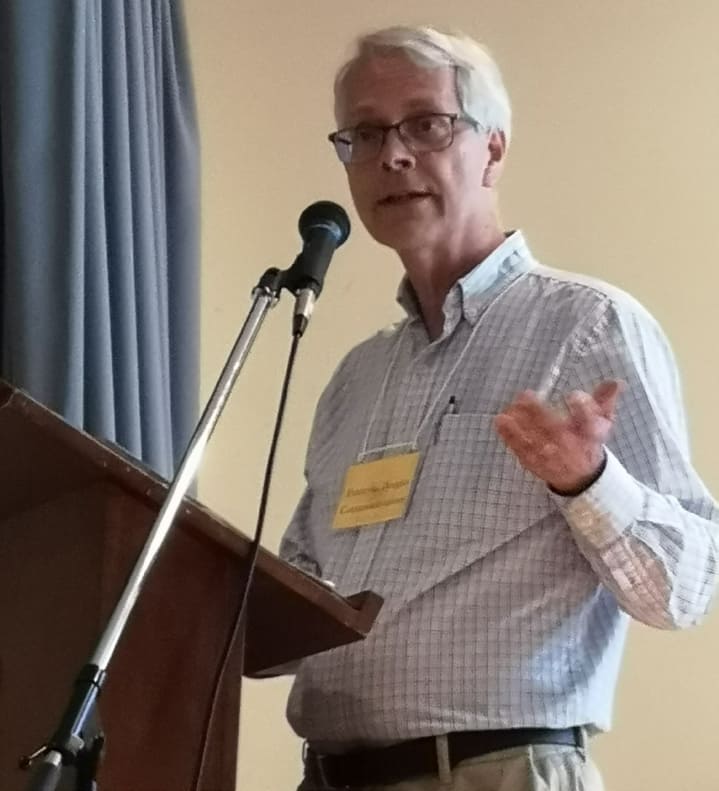 Neighbourhood historian François Bregha, described many prime ministerial homes during his Oct. 9 evening presentation.Sandy Hill is more than just a passing interest for François Bregha. He has lived in Sandy Hill for 34 years. In this time, François has undertaken research on ten prime ministers who have lived in his community, in over a dozen different homes. Many of these homes are still standing, and have become regular stops on François’ community walking tours.
Neighbourhood historian François Bregha, described many prime ministerial homes during his Oct. 9 evening presentation.Sandy Hill is more than just a passing interest for François Bregha. He has lived in Sandy Hill for 34 years. In this time, François has undertaken research on ten prime ministers who have lived in his community, in over a dozen different homes. Many of these homes are still standing, and have become regular stops on François’ community walking tours.
Some of Sandy Hill’s prime ministerial homes are well known, like Stadacona, the Strathcona Apartments and Glensmere. The last of these three was the home of Canada’s eight prime minister, Sir Robert Borden. Built in 1894 for Indian Affairs superintendent Hayter Reed, Borden moved into the home in 1907, giving it the name Glensmere.
After prime minister Borden’s third son, Henry Clifford Borden, moved out in 1941, the home served for 27 years as the Chinese legation, back when the Canadian government considered Taiwan to be “China”. When the much bigger China came to be recognized as the proper “China” in 1972, they established an embassy at the former Our Lady of Charity of the Good Shepherd convent and Glensmere, suddenly empty, was demolished.
Sad, but everyone in attendance for François’ talk at least got a good laugh at the photo he showed of the towering monstrosity that replaced Borden’s elegant abode. Fortunately, Stadacona (Sir John A. Macdonald’s third Sandy Hill home) and the Strathcona Apartments continue to provide architectural dignity on Laurier Avenue East.
Probably the best-known home is Laurier House, built in 1878. Canada’s seventh and tenth prime ministers lived here, although it’s probably less well known that the museum that now honours Sir Wilfrid Laurier and William Lyon Mackenzie King was originally named Kininvie by the home’s first owner, jeweler John Leslie. Leslie named his Sandy Hill home after Kininvie Manor in Banffshire.
This Scottish castle has been in the possession of the Leslie clan since 1521. King renamed the home Laurier House in honour of his mentor, in 1923.
François did some considerable research to dig up information on the many less well-known homes in Sandy Hill. The 13th prime minister, John Diefenbaker not only lived in the Strathcona Apartments, he later rented a small apartment in a house on Wilbrod Street. Our 15th prime minister, Pierre Trudeau, rented an apartment on Besserer Street in the early 1950s, in a home built in 1896 for broker A.M. Sutherland. The home had just been converted to apartments when Trudeau moved in.
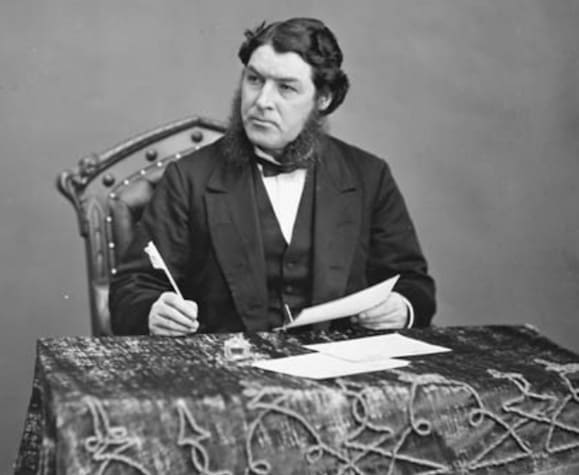 Future prime minister Charles Tupper lived at 274 Daly Ave. in 1872
Future prime minister Charles Tupper lived at 274 Daly Ave. in 1872
Source: Library and Archives CanadaTrudeau’s predecessor, Lester Pearson, seems to have had a particular penchant for Sandy Hill. He lived in three homes in the neighbourhood. Sadly the last of these – the apartment he was living in when he won the Nobel Peace Prize – is slated for demolition. The Ugandan High Commission, which has occupied the building since 1985 has allowed the historic landmark to fall into disrepair.
During the Q&A session with François, special attention was drawn to Canada’s sixth prime minister Sir Charles Tupper who, while on his morning walk to the office at Parliament Hill took a daily diversion to meet up with a lady-friend on Chapel Street. François had hoped to exercise some discretion concerning the affair but was cajoled by the audience to offer some details.
Tupper is unique in having lived in two homes that had also been the home of other prime ministers.
Tupper’s 1872 home at 274 Daly Avenue was converted into apartments in 1982.
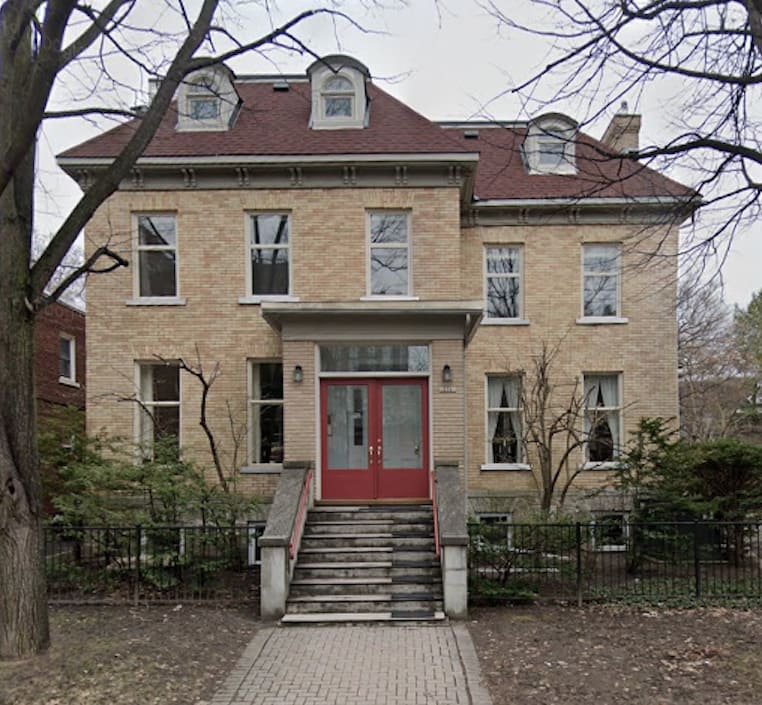 More than a century later, the home was converted into apartments and another future prime minister, Paul Martin, lived there from 1994 to 2003.Paul Martin (our 21st prime minister) lived in one of these units from 1994 until 2003, when he was able to move into 24 Sussex Drive.
More than a century later, the home was converted into apartments and another future prime minister, Paul Martin, lived there from 1994 to 2003.Paul Martin (our 21st prime minister) lived in one of these units from 1994 until 2003, when he was able to move into 24 Sussex Drive.
As for Sir Charles, he later moved to a home named Cliffside, just west of the Parliament Buildings.
This same residence had earlier been the home of Canada’s second prime minister, Alexander Mackenzie. Cliffside was demolished in 1929.
If you’re interested to learn more about Sandy Hill’s many magnificent historic homes, visit the Sandy Hill History website. Here François has more stories, not just of prime ministers, but of business people, war heroes, architects and artists who called Sandy Hill home.



